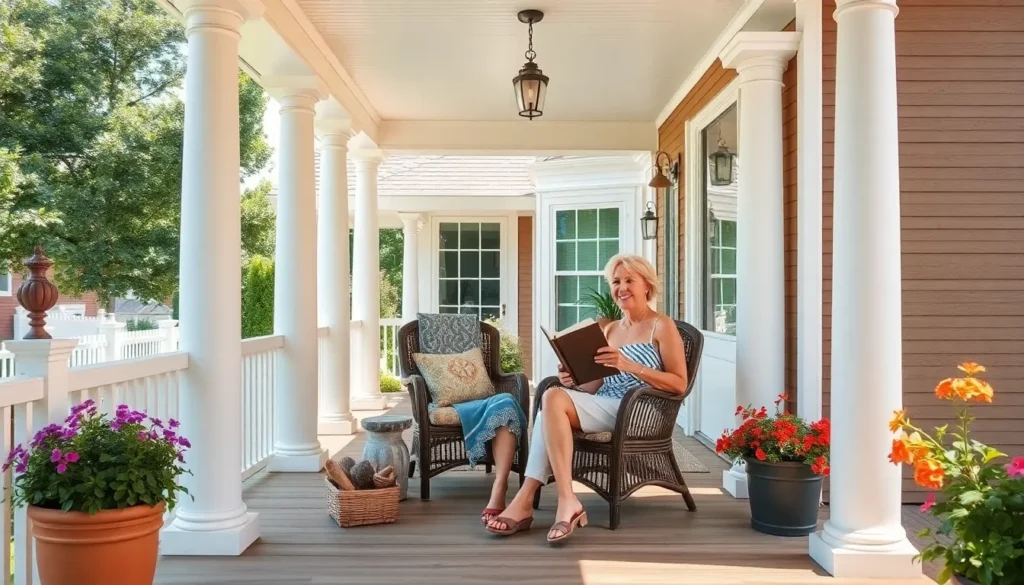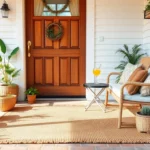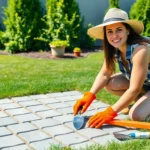We all know that first impressions matter and your front porch serves as the welcoming face of your home. Whether you’re sipping morning coffee or greeting neighbors your front porch deck sets the tone for your entire property’s curb appeal.
The right deck design can transform an ordinary entrance into a stunning focal point that adds both value and functionality to your home. From classic wraparound porches to modern minimalist platforms we’ve seen countless homeowners completely revolutionize their outdoor spaces with smart design choices.
Today’s front porch deck ideas go far beyond basic wooden planks. We’re talking about creative layouts that maximize space incorporate innovative materials and blend seamlessly with your home’s architectural style. Whether you’re working with a compact urban lot or a sprawling suburban property there’s a perfect deck solution waiting to elevate your home’s entrance.
Traditional Wraparound Porch Designs
Traditional wraparound porches create an inviting atmosphere that extends living space while adding important architectural character to any home. We’ve seen these timeless designs consistently increase property values by 10-15% according to real estate professionals.
Classic Southern Style Features
Wide plank flooring serves as the foundation for authentic Southern wraparound designs that capture regional charm. We recommend using pressure-treated pine or cypress boards measuring 5-6 inches wide for that distinctive look. Ceiling fans with paddle blades provide essential airflow while maintaining the traditional aesthetic these porches are known for.
Columns play a crucial role in defining Southern porch character through their substantial presence and proportions. We prefer round columns with diameters ranging from 8-12 inches depending on your home’s scale. White or cream paint finishes emphasize the clean lines that make these designs so appealing.
Railings with simple balusters complement the overall design without overwhelming the space’s natural flow. We typically space balusters 6-8 inches apart to meet safety codes while preserving sight lines. Metal brackets supporting the roof overhang add structural integrity and visual interest to these classic designs.
Colonial-Inspired Elements
Square columns with paneled details reflect the geometric precision that defines Colonial architecture beautifully. We often incorporate recessed panels measuring 12-16 inches in height for authentic proportions. Painted finishes in historical colors like Williamsburg blue or Charleston green enhance the period appropriate appearance.
Dentil molding along the roofline creates sophisticated detail that elevates simple porch designs significantly. We space these rectangular blocks 2-3 inches apart with equal spacing between each element. Crown molding transitions smoothly between the ceiling and supporting beams for professional results.
Brick or stone foundation walls provide the substantial base that Colonial homes require for proper visual weight. We recommend heights of 18-24 inches to create appropriate proportions with most home styles. Natural materials like fieldstone or reclaimed brick add authentic texture and character.
Victorian Decorative Details
Ornate gingerbread trim transforms plain porch edges into elaborate showcase pieces that capture Victorian elegance. We source authentic reproduction pieces or commission custom millwork for unique designs. Scroll patterns and geometric cutouts create the intricate shadows that define this architectural style.
Spindle work balusters feature turned profiles that add vertical interest while maintaining safety requirements effectively. We typically use balusters with 2-3 decorative turns spaced according to local building codes. Painted white or cream finishes highlight the detailed craftsmanship these elements showcase.
Decorative brackets support roof overhangs while serving as sculptural elements that enhance the overall design composition. We position these ornamental supports at column locations and mid-span points for optimal visual balance. Cast iron or carved wood options provide different aesthetic approaches to achieve authentic Victorian character.
Modern Minimalist Front Deck Concepts
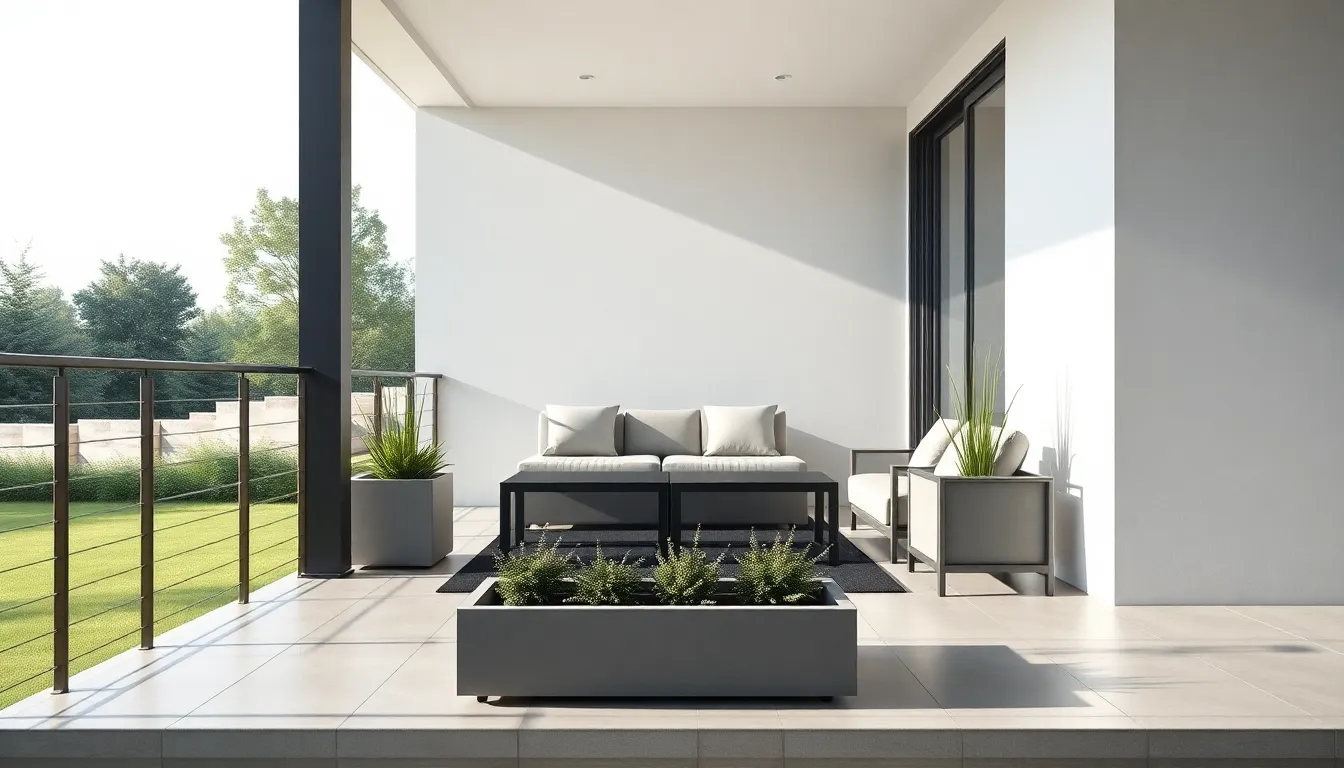
We’re shifting from ornate traditional designs to embrace the beauty of simplicity with modern minimalist front deck concepts. These sleek approaches focus on architectural precision and curated elements that create sophisticated entry spaces.
Clean Lines and Geometric Shapes
Rectangular layouts dominate modern minimalist front deck designs, creating crisp visual boundaries that enhance your home’s contemporary appeal. We prefer straight railings over curved alternatives because they reinforce the geometric aesthetic while maintaining structural integrity. Square step configurations eliminate unnecessary ornamental details, allowing the deck’s fundamental architecture to speak for itself.
Linear elements extend throughout the entire design, from the deck’s perimeter to built-in seating arrangements. Sharp corners replace rounded edges in every component, establishing a cohesive visual language that connects seamlessly with modern home exteriors. Geometric patterns in the decking boards themselves can add subtle interest without compromising the minimalist philosophy.
Contemporary Materials and Finishes
Steel railings with cable systems provide transparency while maintaining that sleek industrial edge we love in modern design. We recommend smooth woods with natural tones because they add warmth without overwhelming the space’s clean aesthetic. Polished concrete surfaces offer durability and complement the minimalist approach with their understated elegance.
Metal grid glass panels create visual lightness while serving functional safety requirements. Matte finishes work better than glossy alternatives since they avoid unwanted reflections that can disrupt the serene atmosphere. Natural wood tones balance the coolness of concrete and steel elements, creating a harmonious material palette.
Glass components integrate seamlessly with large doors or windows, extending the minimalist design principles from interior to exterior spaces. Contemporary materials require minimal maintenance while delivering maximum visual impact through their inherent beauty rather than decorative embellishments.
Sleek Furniture and Accessories
Low profile seating arrangements in neutral colors like white, black, and gray maintain the uncluttered aesthetic we seek in minimalist designs. We choose streamlined furniture with simple forms that complement rather than compete with the deck’s architectural elements. Modern lighting fixtures such as black sconces or brass finished lamps provide functional illumination without visual heaviness.
Planters with clean geometric shapes house simple greenery that adds life without overwhelming the space. Natural fiber rugs introduce subtle texture while staying true to the minimalist ethos through their understated patterns. Dried flower arrangements in whitewashed vases offer organic softness that balances the harder architectural materials.
Jute rugs work particularly well because they reinforce the natural element while maintaining the contemporary vibe. We limit accessories to functional pieces that serve multiple purposes, ensuring every element contributes meaningfully to the overall design concept.
Elevated Deck Platforms for Sloped Yards
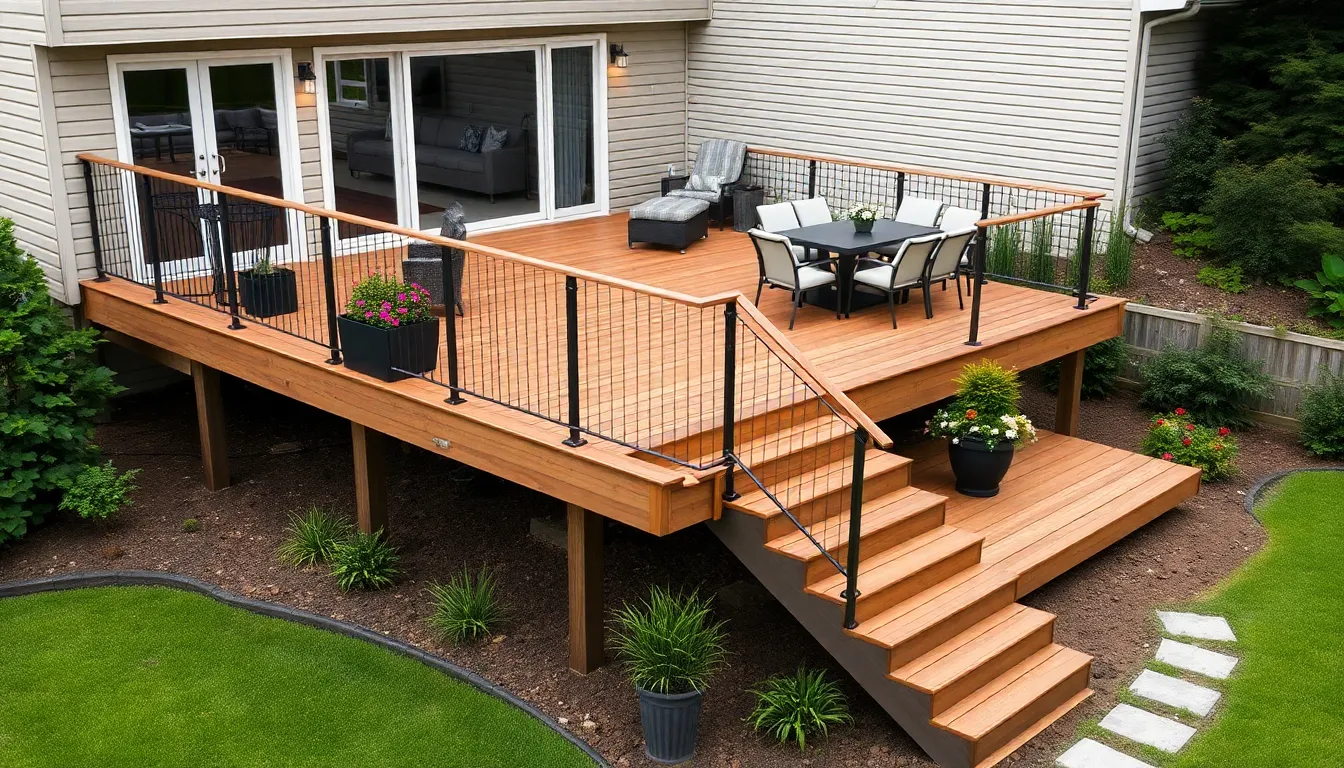
We’ve found that elevated deck platforms offer the perfect solution for homes with challenging terrain. These structures transform unusable sloped yards into functional outdoor spaces without expensive grading work.
Multi-Level Deck Configurations
Creating distinct zones through multi-level deck designs maximizes your sloped property’s potential. We recommend building separate platforms connected by stairs or landings to establish dedicated areas for dining, lounging, and entertaining. Different materials on each level help visually separate spaces while maintaining design cohesion.
Contemporary homeowners favor clean geometric shapes with minimalist metal railings for their multi-level configurations. Mixed decking colors between levels add visual interest without overwhelming the overall aesthetic. Each platform can feature unique design details like varied railing styles or different lighting schemes to define exact purposes.
Transitional spaces between levels create natural flow throughout your elevated deck system. We suggest incorporating landing areas that serve as rest points and visual breaks between major deck sections.
Retaining Wall Integration
Structural retaining walls provide essential foundation support for elevated decks on sloped terrain. We build these walls using stone, concrete, or masonry materials that serve both functional and aesthetic purposes. Proper soil retention creates stable building areas while managing water runoff and erosion concerns.
Dual-purpose retaining walls can function as built-in seating or planter features adjacent to your deck platform. Integrated planters soften the hardscape elements while providing opportunities for landscaping that complements your home’s architecture. Strategic placement of these walls creates natural boundaries between different outdoor zones.
Drainage systems behind retaining walls prevent water buildup that could compromise structural integrity. We always install proper waterproofing and drainage materials to ensure long-term stability of your elevated deck platform.
Staircase Design Options
Connecting your elevated deck levels requires thoughtful staircase planning that balances safety with style. We design stairs using traditional wood construction, sleek metal railings with glass panels, or wide gradual steps that double as informal seating areas. Each option should complement your overall deck aesthetic whether you prefer modern minimalist or rustic farmhouse styles.
Safety features like handrails and adequate lighting are non-negotiable elements in staircase design. Strategic lighting placement illuminates each step while creating ambient outdoor atmosphere during evening hours. Handrail materials should match or complement your deck railing system for visual continuity.
Wide staircase designs offer additional functionality beyond simple transitions between levels. We often incorporate broader steps that serve as gathering spots or display areas for planters and decorative elements that enhance your front porch’s welcoming appeal.
Covered Front Porch Deck Solutions
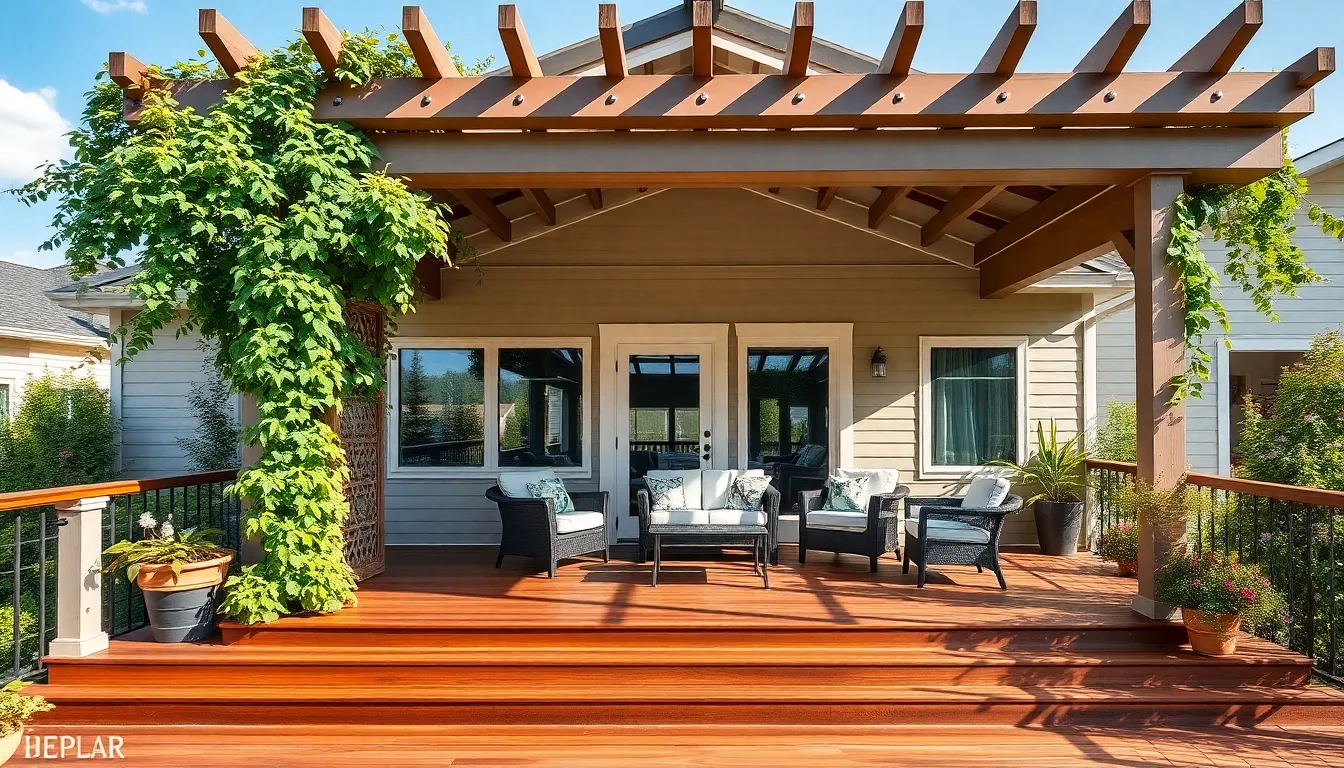
Creating a covered front porch deck transforms your outdoor space into a year-round haven that shields you from weather while maintaining an inviting atmosphere. We’ll explore three essential approaches to achieving comprehensive coverage that enhances both functionality and curb appeal.
Roof Extension Techniques
Extending your main roofline provides the most seamless integration with your home’s existing architecture. Small minimalist extensions work perfectly for compact spaces, offering targeted protection over seating areas without overwhelming the home’s proportions. Large farmhouse-style extensions create expansive covered areas that accommodate multiple furniture groupings and activities.
Proportional sizing ensures your roof extension complements rather than dominates your home’s facade. We recommend extending the roofline to cover at least 8-10 feet of deck depth for optimal weather protection. Portico additions offer an alternative approach, creating a distinct architectural feature that frames your entrance while providing substantial coverage.
Transitional and coastal porch designs benefit from extended rooflines that blend modern materials with traditional forms. These extensions handle weather challenges effectively while maintaining visual coherence with your home’s existing style elements.
Pergola and Gazebo Additions
Pergolas create structured partial shade through their open-beam design, allowing filtered sunlight to reach your deck surface. Installing climbing plants on pergola structures adds natural beauty while increasing shade coverage over time. These additions work exceptionally well when positioned over dining areas or conversation spaces.
Gazebos provide fully enclosed coverage options for front porch decks, creating dedicated outdoor rooms that function regardless of weather conditions. Positioning a gazebo at one end of your deck establishes a focal point while providing flexible shelter options. These structures accommodate various seating arrangements and can house outdoor furniture year-round.
Both pergolas and gazebos enhance design interest through their dimensional qualities, adding vertical elements that break up horizontal deck lines. We find these additions particularly effective when styled to complement your home’s architectural details and material palette.
Weather Protection Strategies
Aluminum shutters with adjustable louvers deliver dual functionality as privacy screens and climate control elements. These shutters allow you to manage airflow while blocking unwanted sun or wind, extending your porch’s usability during challenging weather conditions. Installing shutters on multiple sides provides comprehensive environmental control.
Composite tongue and groove flooring withstands moisture and temperature fluctuations better than traditional wood options. Painted ceilings reflect light and resist weather damage while contributing to your porch’s aesthetic appeal. These material choices create covered porches that maintain both comfort and structural integrity.
Incorporating aluminum railings with weather-resistant finishes ensures long-term durability without compromising style. Strategic placement of these protective elements creates microclimates within your covered space, allowing comfortable use during various weather conditions throughout the year.
Small Space Front Deck Maximization
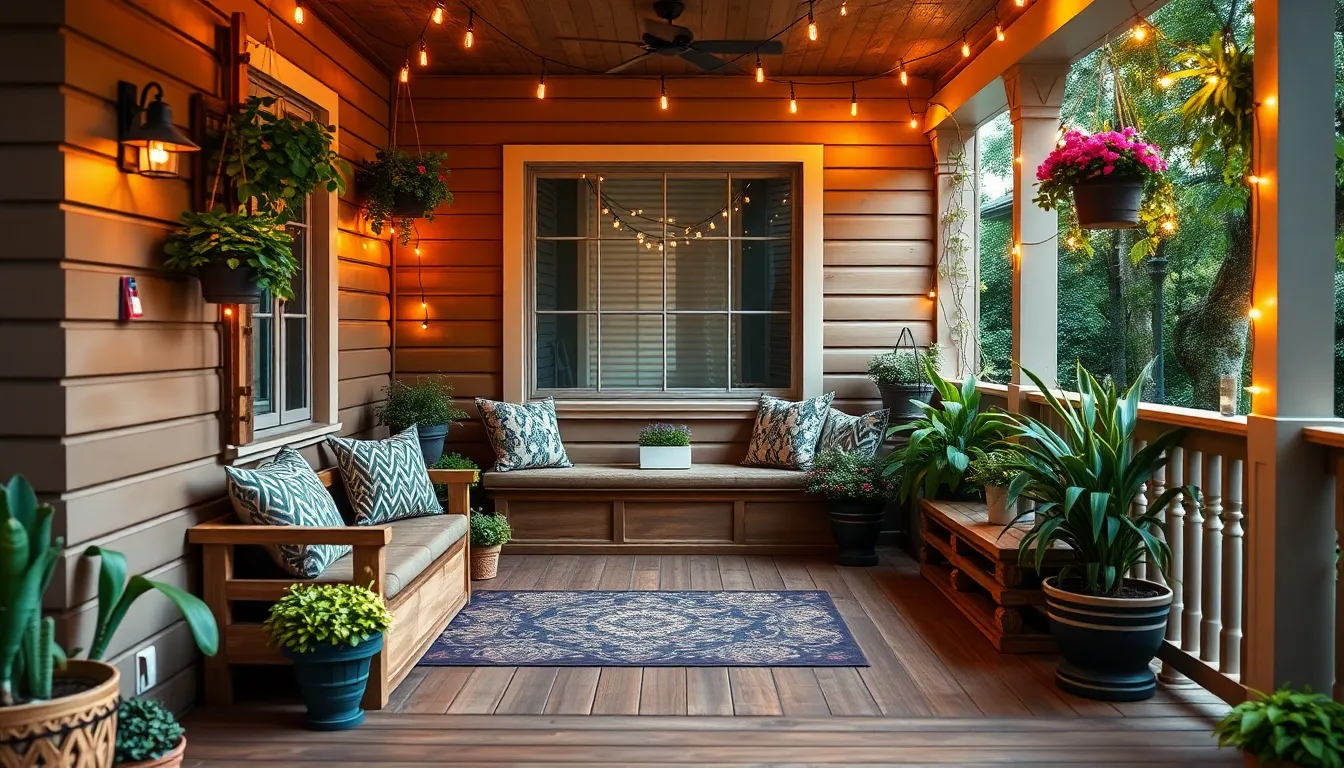
Small front porch decks present unique opportunities to create functional outdoor spaces without overwhelming your home’s footprint. We’ll explore strategic approaches that transform compact areas into inviting extensions of your living space.
Compact Design Strategies
Built-in benches maximize seating capacity while preserving valuable floor space for movement and activities. L-shaped seating arrangements work particularly well in corner configurations, allowing us to accommodate more guests without cluttering the deck area. Floor pillows offer flexible seating answers that can be easily stored when not needed, creating a casual boho atmosphere that adapts to your entertaining style.
Strategic furniture placement along deck edges improves traffic flow through the center of the space. Positioning lightweight, stackable chairs against railings ensures easy reconfiguration for different occasions. Integrated planters built into railings and steps conserve precious square footage while adding natural beauty to your compact deck design.
Thoughtful layout planning ensures every inch serves a purpose without creating cramped conditions. We recommend measuring your space carefully and selecting furniture pieces that complement rather than compete with your deck’s proportions.
Vertical Space Utilization
Trellises mounted on walls or railings provide growing space for climbing plants without consuming floor area. Hanging planters suspended from overhead structures create layers of greenery that draw the eye upward and make small spaces feel larger. Vertical gardens installed on privacy screens or exterior walls transform blank surfaces into living art installations.
String lights strung overhead add ambiance while utilizing air space that typically goes unused. Wall-mounted shelving provides display areas for decorative items or potted plants without reducing walkable deck space. Privacy screens extend vertically to create intimate outdoor rooms that feel separate from neighboring properties.
Lattice work serves dual purposes by providing plant support and visual screening simultaneously. We’ve found that incorporating vertical elements helps small decks feel more substantial and thoughtfully designed.
Multi-Functional Elements
Storage benches combine comfortable seating with hidden compartments for cushions, gardening tools, or outdoor accessories. Steps designed with deeper treads can double as display areas for potted plants or casual seating during gatherings. Railings equipped with integrated planters eliminate the need for separate plant stands while adding continuous greenery.
Foldable furniture pieces adapt to changing needs throughout the day and seasons. Movable cushions and pillows allow quick transformation from intimate reading nook to social gathering space. Ottoman-style seating provides footrests, extra seating, and storage answers in one compact piece.
Privacy screens that incorporate shelving or hooks maximize functionality while defining your outdoor space. We recommend selecting pieces that serve at least two purposes to make the most of your limited square footage.
Rustic and Farmhouse Deck Styling
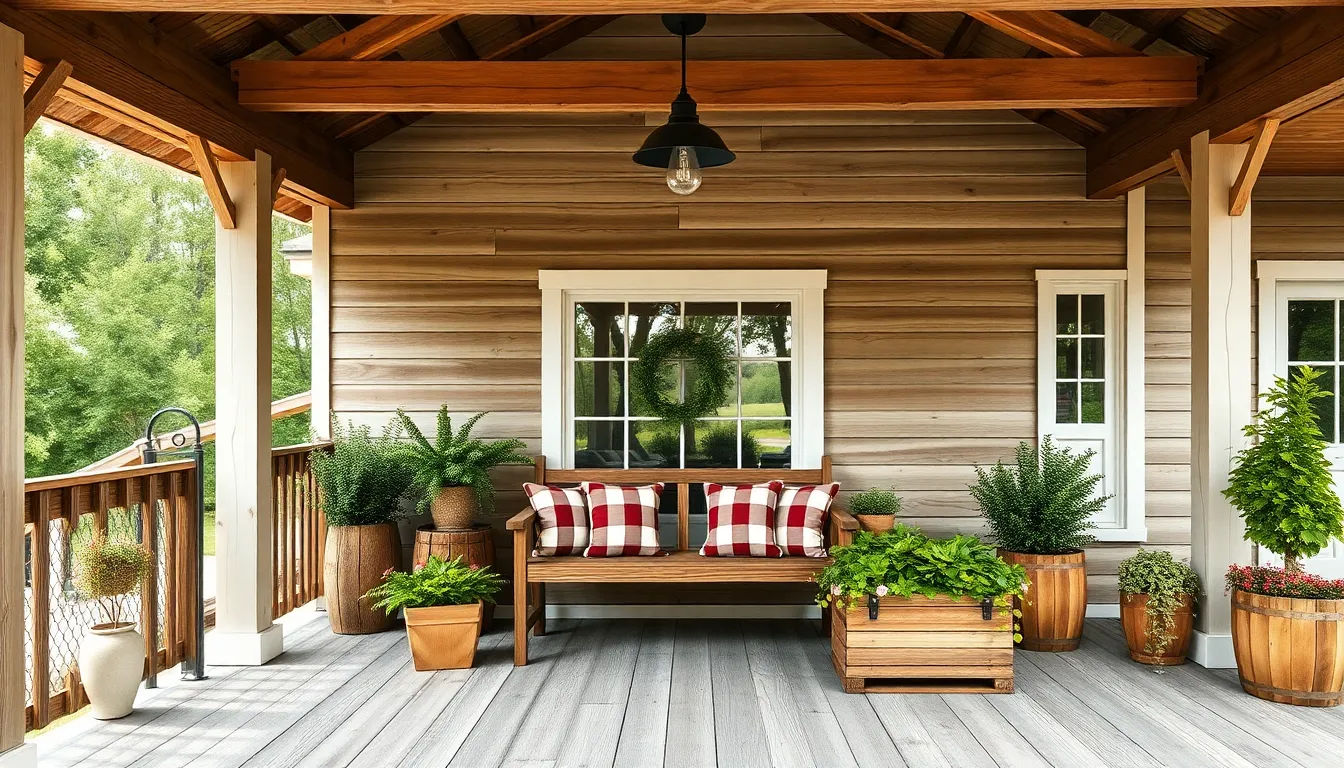
Farmhouse deck styling brings warmth and comfort to your front porch through carefully selected elements that create a welcoming atmosphere. We’ll explore how reclaimed materials, vintage fixtures, and country colors work together to achieve this timeless aesthetic.
Reclaimed Wood Applications
Reclaimed wood serves as the foundation for authentic farmhouse deck design. We recommend using weathered planks for your decking surface to introduce natural imperfections and patina that add character to your space. Railings crafted from repurposed barn wood create visual continuity while supporting the rustic theme throughout your porch.
Planters built from reclaimed materials offer both function and style for your farmhouse deck. We often incorporate these wooden containers filled with ferns or greenery to add natural texture and freshness. Furniture pieces like benches or side tables constructed from salvaged wood enhance the lived-in feel that defines farmhouse styling.
The eco-friendly nature of reclaimed wood makes it an excellent choice for sustainable home design. We appreciate how repurposing these materials reduces waste while creating a sense of history in your outdoor space. Each piece tells a story through its weathered surface and unique grain patterns.
Vintage Hardware and Fixtures
Matte black gooseneck lighting fixtures dominate farmhouse porch designs for their vintage charm and functional illumination. We select these fixtures because they combine practical lighting with the nostalgic mood that characterizes country styling. Their simple, functional designs root directly in traditional farm life aesthetics.
Barn door style handles and wrought iron accents enhance the authentic farmhouse vibe throughout your deck space. We incorporate these dark metal elements into door hardware, decorative brackets, and railing details to create visual consistency. Their durability matches their authentic appearance, ensuring your fixtures withstand outdoor conditions.
Traditional hardware often features simple geometric shapes that complement rustic wood textures. We choose pieces with minimal ornamentation to maintain the unpretentious character that defines farmhouse design. These elements work together to create authenticity without overwhelming your porch’s natural materials.
Country-Inspired Color Schemes
White and cream tones create the foundation for traditional farmhouse porch color palettes. We use these light colors to establish an airy, welcoming atmosphere that reflects countryside inspiration. Soft grays and muted earth tones complement these primary colors while maintaining the gentle aesthetic.
Black accents provide sophisticated contrast against the neutral base colors in farmhouse designs. We strategically place dark elements like doors, window trim, and lighting fixtures to add visual weight and definition. This classic combination creates timeless appeal that enhances your home’s curb appeal.
Plaid and striped patterns in cushions and pillows introduce classic country colors to your seating areas. We incorporate reds, blues, and greens through these textiles to reflect traditional farm patterns. These accent colors enhance the cozy aesthetic while maintaining the overall soft palette that defines farmhouse styling.
Seasonal Decoration and Landscaping Ideas

Decorating your front porch deck throughout the year keeps your home’s entrance fresh and inviting. We’ll explore how strategic seasonal plantings and décor choices can transform your outdoor space into a year-round showcase.
Spring and Summer Plant Arrangements
Colorful flowering perennials create vibrant displays at entryways and railings during warmer months. We recommend selecting container plants that match your planter colors with seasonal blooms for maximum visual impact. Arrange these containers near your front door to establish immediate visual interest while complementing your existing yard greenery.
Lush greenery placement in built-in beds and deck planters generates a fresh atmosphere perfect for summer entertaining. Position lightweight outdoor furniture in bright natural tones to complement your floral displays. Consider incorporating trailing plants like petunias or ivy in elevated planters to add vertical dimension to your deck space.
Strategic plant positioning around windows frames views from both inside and outside your home. This thoughtful arrangement maintains natural daylight flow while creating visual rhythm across your porch. Use varying heights of planters and stands to create depth and prevent your arrangement from appearing flat or monotonous.
Fall and Winter Seasonal Displays
Autumnal color transitions using pumpkins, gourds, and dried floral arrangements bring warmth to cooler months. We suggest incorporating orange, deep reds, and gold hues throughout your porch décor to create a cohesive seasonal theme. Layer these elements on steps, tables, and in planters for a rich, textured appearance.
Seasonal wreaths and cozy accessories like weather resistant blankets or cushions extend your porch’s usability into cooler weather. Position these items strategically to invite lingering and conversation even as temperatures drop. Add battery operated string lights or lanterns to maintain evening appeal during shorter daylight hours.
Weather resistant décor elements ensure your seasonal displays remain attractive throughout autumn and winter storms. Choose materials like artificial berries, preserved branches, and quality outdoor fabrics that withstand moisture and wind. Replace fresh elements with dried alternatives that maintain their appearance longer in challenging weather conditions.
Year-Round Greenery Options
Evergreen shrubs and hardy plants in industry beds around your deck provide consistent greenery visible from the porch throughout all seasons. We recommend boxwoods, ornamental grasses, and dwarf conifers that survive variable weather while maintaining structure and color. These plants create a reliable foundation that supports your seasonal decorating efforts.
Container gardening with hardy species offers flexibility for year-round appeal without permanent landscaping changes. Select plants like rosemary, lavender, or ornamental kale that provide both visual interest and practical benefits. Group containers of varying sizes to create ever-changing displays that can be rearranged as seasons change.
Design continuity techniques link your porch plants with nearby yard areas to maintain visual harmony regardless of season. Repeat plant varieties or color schemes between your deck containers and surrounding industry beds. This approach creates a seamless transition from your home’s architecture to the natural environment, improving overall curb appeal.
Material Selection and Durability Considerations
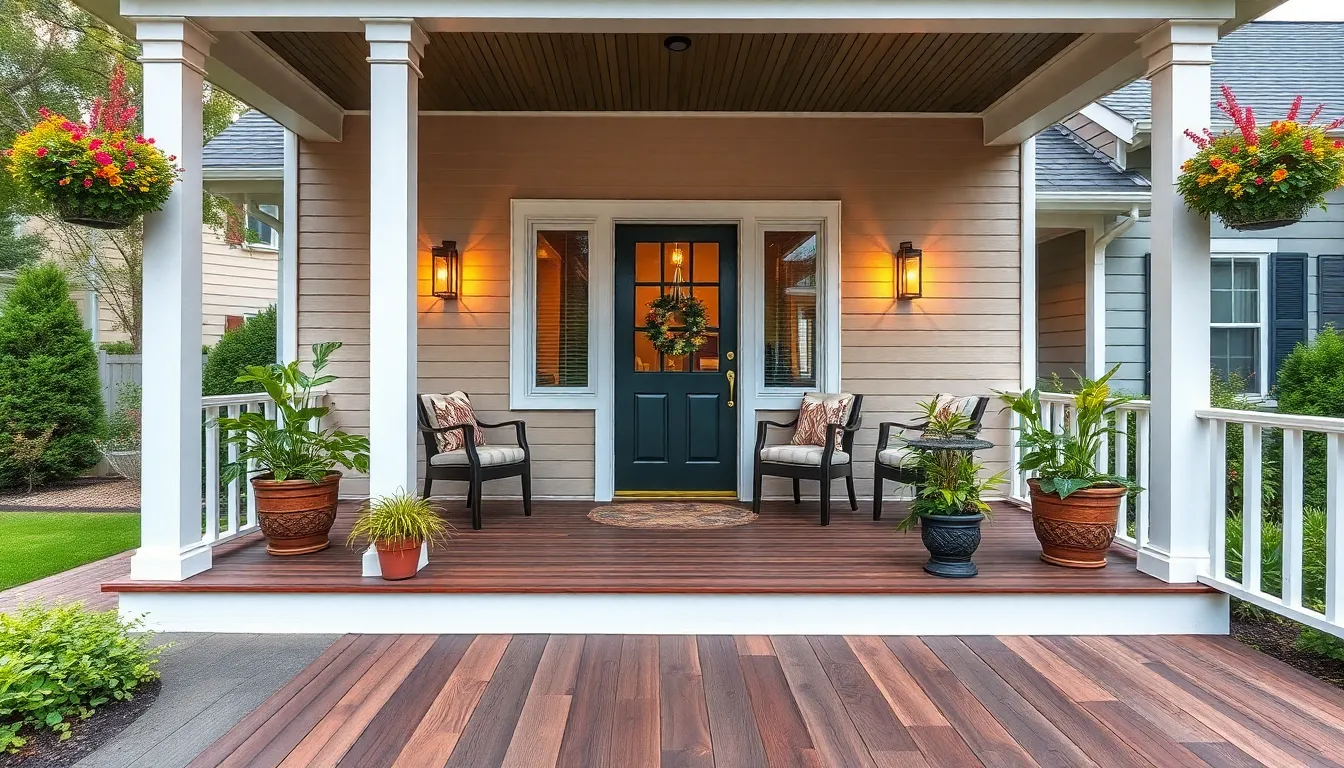
Choosing the right decking material for your front porch impacts both its longevity and maintenance requirements. We’ll explore the key options and their performance characteristics to help you make an well-informed choice.
Composite Decking Advantages
Composite decking delivers exceptional durability through its polymer construction and wood-plastic blend composition. We observe that this material typically lasts 30 to 50 years, significantly outperforming traditional wood options that last only 10 to 30 years. Weather resistance stands as its primary strength, offering protection against rot, fading, and insect damage without compromising structural integrity.
Maintenance demands remain minimal with composite materials, requiring only occasional soap and water cleaning. We appreciate that this material eliminates the need for sealing, staining, or painting throughout its lifespan. Cost effectiveness emerges over time even though higher initial investment, making composite decking an intelligent choice for homeowners prioritizing long term value and convenience.
Natural Wood Options
Natural wood decking provides timeless aesthetic appeal that complements rustic, colonial, and Victorian architectural styles. We find that wood’s warm appearance and classic beauty make it a preferred choice for traditional front porch designs. Versatility allows wood to serve multiple functions, commonly appearing in railings and screened porch frames even when other materials are selected for the main decking surface.
Architectural cohesion becomes easier to achieve with wood’s natural characteristics and ability to accept various stains and finishes. We notice that wood maintains its popularity across different design preferences due to its authentic appearance and traditional charm. Integration with existing home elements flows naturally when wood decking matches or complements other wooden architectural features.
Maintenance Requirements
Composite materials demand minimal upkeep, typically requiring only periodic cleaning with basic household products. We recommend this option for homeowners seeking hassle free outdoor living spaces. Structural integrity remains stable without additional treatments or protective coatings over the material’s extended lifespan.
Wood decking requires consistent maintenance including sealing, staining, or painting every few years to preserve appearance and structural soundness. We must address potential issues like splinters, cracks, and rot through regular repairs and preventive treatments. Protection against moisture damage becomes crucial for maintaining wood’s longevity and safety standards.
Design considerations should factor in your lifestyle preferences and available time for maintenance activities. We suggest evaluating your long term commitment to upkeep when selecting between these material options for optimal satisfaction with your front porch deck investment.
Budget-Friendly DIY Front Porch Projects
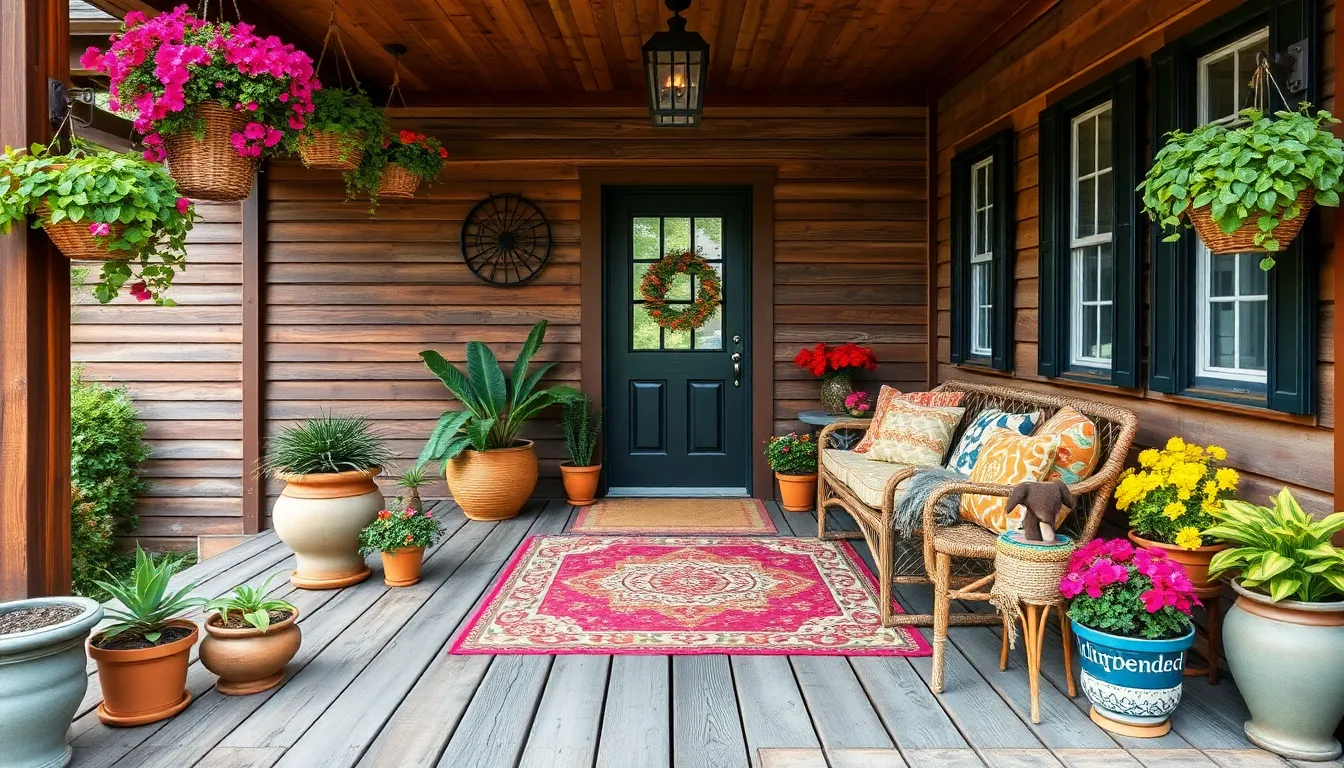
Creating an inviting front porch doesn’t require a massive renovation budget. We’ll explore practical ways to transform your entrance using affordable materials and simple techniques that deliver maximum impact.
Cost-Effective Material Choices
Wood remains our top recommendation for budget-conscious homeowners, especially when you source untreated or reclaimed lumber for decking and steps. Reclaimed materials offer character and sustainability while significantly reducing costs compared to new premium lumber.
Masonry paint transforms concrete porch floors at a fraction of the cost of new tiles or resurfacing. We recommend thoroughly cleaning existing slabs with a power washer before applying specialized masonry paint, which brightens and protects the surface for years.
Potted plants and hanging baskets provide natural decoration without the expense of built-in landscaping. These portable options allow you to change your design seasonally while avoiding costly permanent fixtures that require professional installation.
| Material Type | Cost Range | Durability | Maintenance Level |
|---|---|---|---|
| Reclaimed Wood | $3-8 per sq ft | 15-25 years | Medium |
| Masonry Paint | $25-40 per gallon | 5-10 years | Low |
| Basic Lumber | $2-6 per sq ft | 10-20 years | High |
Simple Construction Techniques
Building small decks or steps with wooden planks requires only basic carpentry skills and minimal tools. We suggest starting with simple rectangular platforms that can be constructed by driving planks into the ground, making this approach perfect for beginner DIYers.
Power washing and painting existing surfaces eliminates the complexity and expense of full replacement projects. This technique works particularly well on concrete porches where you can use stencils to create decorative patterns after cleaning.
Vertical gardening using plant stands or grouped containers maximizes your space with minimal structural work. We recommend arranging plants in odd-numbered groupings to create visual interest while leveraging vertical space effectively.
Money-Saving Design Tips
Focused themes like Southwestern, Classic Americana, or Farmhouse styles rely on carefully chosen accent pieces rather than expensive renovations. We’ve found that committing to a exact aesthetic helps you make targeted purchases that create cohesive looks without overspending.
Grouping techniques for plants and décor create dramatic visual impact without requiring many individual purchases. Arranging items in clusters of three or five naturally draws the eye and makes your porch feel more intentionally designed.
Outdoor textiles like inexpensive rugs and cushions instantly elevate your porch’s charm while staying within budget. Adding curtains blocks bugs and creates a resort-like atmosphere that transforms the entire space feeling.
Simple updates deliver outsized returns when you focus on high-impact elements like painting your front door or installing lantern sconces. We recommend prioritizing these focal points that guests notice immediately over smaller decorative details that might go unnoticed.
Lighting and Safety Feature Integration
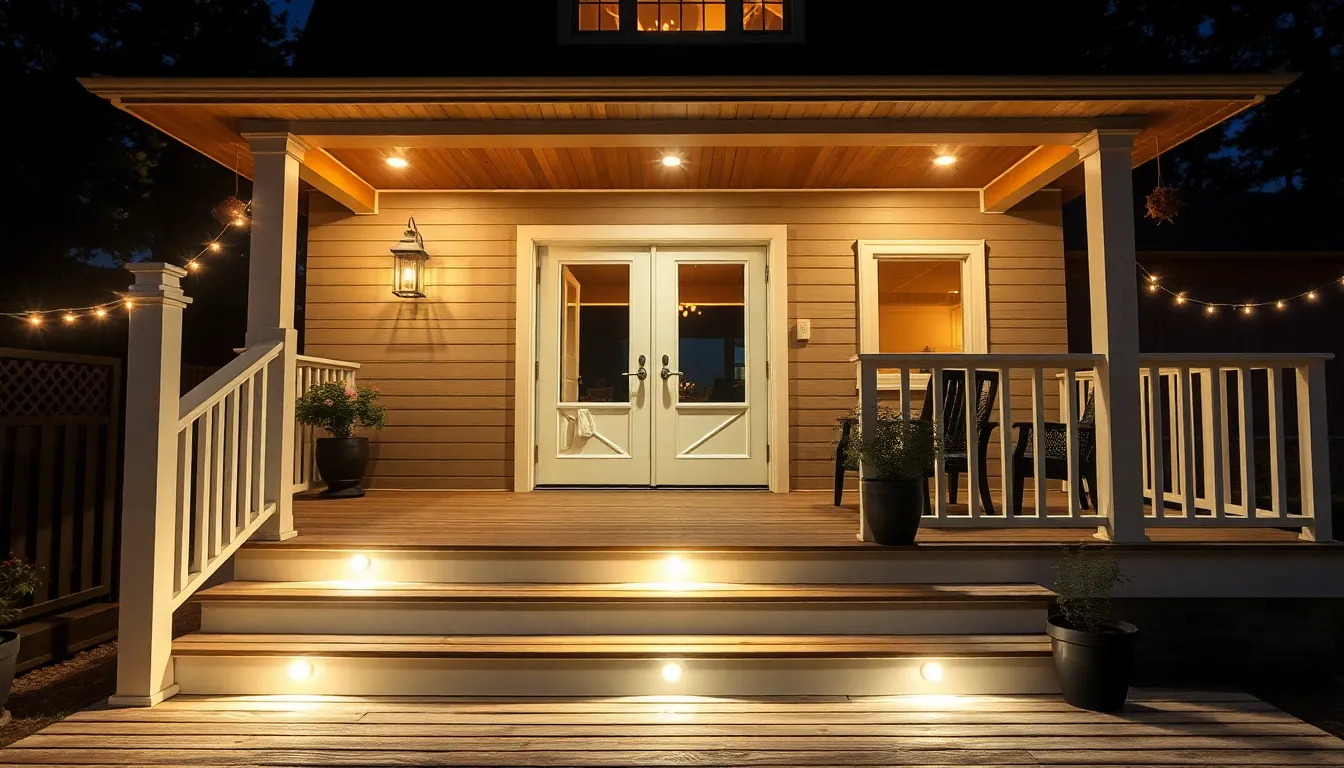
Thoughtful lighting design transforms your front porch deck into a welcoming and secure space that functions beautifully day and night. We’ll explore strategic lighting placement and essential safety features that enhance both functionality and curb appeal.
Ambient Lighting Answers
In-deck lights create subtle illumination by installing flush with the deck surface, guiding foot traffic along walkways and highlighting architectural details without overwhelming the space. These recessed fixtures provide consistent lighting that enhances safety while maintaining a clean aesthetic.
Under-rail lighting positions discreet LED strips beneath deck railings to highlight railing designs and brighten the area below. This placement strategy improves safety by illuminating potential hazards while creating an elegant glow that adds depth to your porch design.
String lights bring festive charm when installed overhead or along railings, creating a cozy atmosphere perfect for evening gatherings. They provide gentle illumination that transforms your front porch into an inviting space for relaxation and entertaining.
Post cap lights mount on railing posts to soften the overall look while delivering practical lighting at key points around the deck. These decorative fixtures combine functionality with style, serving as both lighting answers and architectural accents.
Security Lighting Placement
Motion-sensor lights activate automatically near stairs and entrances, illuminating areas promptly when activity is detected while conserving energy. Strategic placement of these fixtures enhances security by deterring unwanted visitors and ensuring safe navigation during nighttime hours.
Spotlights cover darker corners of the porch and surrounding yard areas, increasing visibility and discouraging intruders. Position these fixtures to eliminate blind spots while avoiding glare that might disturb neighbors or create harsh shadows.
Recessed lighting embeds in overhead porch covers or soffits to provide consistent illumination without obstruction or glare. Weather-protected fixtures ensure reliable performance while maintaining clean sight lines and protecting bulbs from the elements.
Railing and Step Safety Measures
Riser lights build directly into stair risers to illuminate each step clearly, preventing trips and falls through practical integration with the stair structure. These small fixtures provide essential visibility while maintaining a streamlined appearance that complements your deck design.
Non-slip railings feature secure grips and durable materials, with integrated lighting making edges more visible during low-light conditions. Combining sturdy construction with enhanced visibility creates a safer environment for all users.
Step edge lighting uses LED strips or embedded fixtures on stair edges to improve visibility while adding modern design elements. This approach ensures clear step definition in challenging lighting conditions while contributing to the overall aesthetic appeal.
Continuous handrails extend along all stairways to comply with safety codes and assist users, especially during wet or icy conditions. Sturdy, uninterrupted railings provide essential support while maintaining design continuity throughout your front porch deck.
Conclusion
We’ve explored countless ways to transform your front entrance into a stunning focal point that reflects your personal style while boosting your home’s value. From classic wraparound porches to sleek modern designs and budget-friendly DIY answers there’s truly an option for every homeowner and every space.
The key lies in choosing elements that complement your home’s architecture while meeting your functional needs. Whether you opt for durable composite materials or embrace the natural beauty of reclaimed wood your front porch deck becomes an extension of your living space that welcomes guests and creates lasting memories.
Remember that even small changes can make a important impact. Strategic lighting thoughtful plantings and carefully chosen accessories work together to create an inviting atmosphere that enhances your home’s curb appeal year-round. Your front porch deck isn’t just an entrance—it’s the foundation of your home’s first impression.
Frequently Asked Questions
What is the best material for a front porch deck?
Composite decking offers the best combination of durability and low maintenance, lasting 30-50 years compared to wood’s 10-30 years. It’s weather-resistant and cost-effective long-term. Natural wood provides timeless aesthetic appeal but requires regular sealing and staining. Choose composite for minimal upkeep or wood for classic beauty with higher maintenance commitment.
How much value does a wraparound porch add to a home?
A well-designed wraparound porch can increase property values by 10-15%. These porches create an inviting atmosphere and enhance curb appeal significantly. The classic Southern style features like wide plank flooring, ceiling fans, and round columns contribute to architectural character, making homes more attractive to potential buyers.
Can I build a front porch deck on a sloped yard?
Yes, elevated deck platforms are an excellent solution for sloped yards. They transform challenging terrain into functional outdoor spaces without costly grading. Multi-level configurations create distinct zones for different activities, while structural retaining walls provide support and aesthetic appeal. Proper drainage systems ensure long-term stability.
What are some budget-friendly DIY front porch ideas?
Use untreated or reclaimed lumber for decking, refresh concrete with masonry paint, and create vertical gardens with potted plants. Simple construction techniques require basic carpentry skills and minimal tools. High-impact updates like painting the front door or installing lantern sconces significantly enhance charm while staying within budget.
How can I maximize a small front porch space?
Incorporate built-in benches and L-shaped seating to maximize seating while preserving floor space. Utilize vertical space with trellises, hanging planters, and string lights. Choose multi-functional elements like storage benches and foldable furniture. Every design element should serve a purpose while maintaining an inviting atmosphere.
What lighting options work best for front porches?
Combine in-deck lights, under-rail lighting, and string lights for ambiance and safety. Install motion-sensor lights and spotlights for security. Add riser lights on steps and ensure continuous handrails for safe navigation. Layer different lighting types to create a welcoming atmosphere while maintaining visibility and security.
How do I create a farmhouse-style front porch?
Use reclaimed wood for decking and railings to add character and sustainability. Install vintage hardware like matte black gooseneck lighting and barn door handles. Choose country-inspired colors including whites, creams, and muted earth tones. Incorporate plaid and striped patterns in textiles to enhance the cozy farmhouse aesthetic.
What plants work best for year-round porch appeal?
Plant colorful flowering perennials for spring and summer, complemented by lush greenery and trailing plants. Use evergreen shrubs and hardy plants for year-round structure. Add seasonal elements like pumpkins and gourds for fall. Choose weather-resistant plants that link your porch with surrounding landscaping for design continuity.

